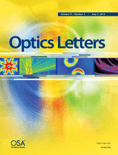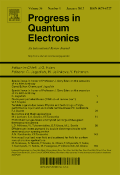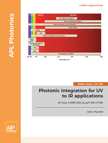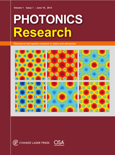
OPTICS LETTERS
Scope & Guideline
Your Gateway to High-Impact Optical Discoveries
Introduction
Aims and Scopes
- Laser Technologies and Applications:
Research related to various laser technologies, including fiber lasers, semiconductor lasers, and solid-state lasers, focusing on their development, optimization, and applications in different fields. - Optical Materials and Devices:
Studies on the development and characterization of novel optical materials, including thin films, metamaterials, and photonic crystals, and their integration into devices for applications in telecommunications, sensing, and imaging. - Photonics and Quantum Technologies:
Research exploring the intersection of photonics and quantum technologies, including quantum imaging, quantum communication, and quantum sensing, emphasizing both theoretical and experimental advancements. - Nonlinear Optics and Light-Matter Interaction:
Investigations into nonlinear optical phenomena, such as frequency conversion, solitons, and light-matter interactions, contributing to the understanding and application of these effects in advanced optical systems. - Optical Communication and Networking:
Development and analysis of optical communication systems, including wavelength division multiplexing, optical signal processing, and fiber-optic networks, with a focus on enhancing capacity and efficiency. - Imaging and Sensing Technologies:
Research into advanced imaging techniques and sensing technologies, including optical coherence tomography, hyperspectral imaging, and various sensing modalities for biomedical and environmental applications.
Trending and Emerging
- Integrated Photonics and Nanophotonics:
There is a growing emphasis on integrated photonic devices, particularly those utilizing nanophotonics principles, for applications in telecommunications, sensing, and quantum technologies. - Machine Learning and AI in Optics:
The integration of machine learning and artificial intelligence in optical systems is emerging as a critical area of research, facilitating advancements in imaging, data analysis, and system optimization. - Quantum Technologies and Quantum Computing:
Research in quantum optics and quantum information science is rapidly expanding, focusing on applications in quantum communication, quantum cryptography, and quantum computing. - Advanced Laser Materials and Nonlinear Effects:
There is a significant interest in developing new laser materials and exploring nonlinear optical effects, leading to innovative laser sources and new applications in frequency conversion and ultrafast optics. - Sustainable and Green Photonics:
The push for sustainability has prompted research into environmentally friendly materials and technologies in optics, including energy-efficient devices and renewable energy applications.
Declining or Waning
- Traditional Optical Coatings:
Research on traditional optical coatings has decreased as newer materials and technologies, such as metamaterials and nanostructured surfaces, have gained prominence, leading to a shift towards more innovative solutions. - Basic Laser Physics:
While foundational studies in laser physics are still relevant, there has been a noticeable decline in publications focusing solely on basic principles, as the field shifts towards practical applications and advanced laser technologies. - Conventional Optical Imaging Techniques:
The interest in conventional optical imaging methods is waning as advanced imaging technologies, such as computational imaging and deep learning-based approaches, increasingly dominate the research landscape. - Standard Fiber Optic Sensors:
Research focused on traditional fiber optic sensors has seen a decline as new sensor technologies emerge, including those utilizing photonic integrated circuits and advanced sensing materials. - Static Optical Devices:
Interest in static optical devices has diminished in favor of more dynamic and reconfigurable systems, such as tunable lasers and adaptive optics, reflecting a trend toward versatility and functionality.
Similar Journals

JOURNAL OF RUSSIAN LASER RESEARCH
Navigating the Frontiers of Laser ApplicationsThe Journal of Russian Laser Research, published by Springer, stands as a vital resource for researchers and professionals in the fields of atomic and molecular physics, as well as optics and engineering. With its ISSN 1071-2836 and E-ISSN 1573-8760, this journal has been disseminating groundbreaking research since its inception in 1994, with a dedicated focus on the advancement of laser technologies and their applications. While it currently holds a Q4 classification in both Atomic and Molecular Physics and Engineering categories, its commitment to fostering novel insights and innovative methodologies positions it as a promising platform for emerging studies within these disciplines. Although the journal does not offer open access options, it continues to draw attention with a growing citation index. By publishing diverse research articles, reviews, and critical discussions, the Journal of Russian Laser Research not only enriches academic literature but also serves as a stepping stone for students and professionals seeking to deepen their understanding of laser science and its myriad applications.

PROGRESS IN QUANTUM ELECTRONICS
Exploring the Frontiers of Quantum InnovationPROGRESS IN QUANTUM ELECTRONICS, published by PERGAMON-ELSEVIER SCIENCE LTD, is a premier international journal that serves as a critical forum for the dissemination of high-quality research in the fields of atomic and molecular physics, electrical engineering, and materials science. With its esteemed Q1 category ranking in several disciplines, including Atomic and Molecular Physics, Electrical and Electronic Engineering, and Electronic, Optical and Magnetic Materials, this journal commands a high impact factor and is recognized for its rigorous peer-review process. Established in 1969 and evolving through various phases, the journal currently compiles cutting-edge research that drives advancements in quantum technologies. Researchers, professionals, and students alike are invited to explore a wealth of knowledge and stay updated on pioneering developments in quantum electronics, enhancing their understanding and contributing to the progression of this dynamic field.

Journal of Optics-India
Fostering Cutting-Edge Discoveries in OpticsThe Journal of Optics-India, published by SPRINGER INDIA, serves as a vital platform dedicated to advancing research in the field of optics, focusing on topics in both atomic and molecular physics. With an ISSN of 0972-8821 and an E-ISSN of 0974-6900, the journal has been a consistent contributor to the field since its inception in 1996 and continues to thrive with its anticipated convergence through 2024. Although currently classified in Q3 of the 2023 category quartiles, the journal actively seeks to elevate its standing within Scopus rankings in physics and astronomy, where it holds a rank of 143/224, indicating significant opportunities for growth and research impact. The Journal of Optics-India is committed to fostering innovative research and providing scholars and practitioners with access to cutting-edge findings, thereby enhancing global conversations around optics and its vast applications. As a reliable source for researchers, professionals, and students alike, the journal emphasizes quality contributions that shape the future of optical science.

ACTA OPTICA SINICA
Fostering Insights in Electronic and Optical MaterialsACTA OPTICA SINICA is a distinguished journal dedicated to the field of optics and photonics, published by the Chinese Laser Press. With an ISSN of 0253-2239, this journal has been an essential resource since its inception, covering significant discoveries and advancements in atomic and molecular physics, electronic materials, and optical sciences. The journal is indexed in Scopus, achieving respectable ranks as Q3 in both Atomic and Molecular Physics, and Optics and Electronic, Optical and Magnetic Materials, reflecting its engagement with current research trends. Although it is not an open-access journal, ACTA OPTICA SINICA is hosted from Shanghai, China, and continues to serve as a vital platform for researchers, professionals, and students alike to disseminate and access high-quality peer-reviewed articles, ensuring its prominent place in the academic discourse related to optics and material sciences.

Chinese Optics
Exploring the Depths of Optical Science and Technology.Chinese Optics is a premier journal dedicated to advancing the field of optics, encompassing research on atomic and molecular physics. Published by the esteemed Changchun Institute of Optics Fine Mechanics & Physics in China, this journal supports the sharing of cutting-edge findings since its inception in 2010. With an ISSN of 2097-1842, it operates within a competitive landscape, currently positioned in Q3 of the category for Atomic and Molecular Physics and Optics, according to the 2023 metrics. While the journal is not open access, it offers a valuable platform for researchers, professionals, and students to explore and contribute to significant discoveries in the realm of optics and light technology. By fostering scholarly communication, Chinese Optics plays a crucial role in bridging theoretical and practical aspects, making it an indispensable resource for those passionate about the optical sciences.

Nonlinear Optics Quantum Optics-Concepts in Modern Optics
Charting New Territories in Nonlinear and Quantum OpticsNonlinear Optics Quantum Optics-Concepts in Modern Optics is a specialized journal published by OLD CITY PUBLISHING INC, focusing on the forefront of research in nonlinear optics and quantum optics. With an ISSN of 1543-0537 and an E-ISSN of 1944-8325, this journal serves as a pivotal platform for the dissemination of innovative concepts and findings in modern optics, significant for both theoretical exploration and practical applications. Established in 2003, the journal's scope encompasses critical areas such as atomic and molecular physics, optical materials, and instrumentation, attracting submissions from a diverse range of interdisciplinary fields. While the journal currently maintains a Q4 ranking in several categories, it continues to strive for higher visibility and impact in the academic community. Researchers and students alike will find valuable insights and contributions that foster advancements in optical science and engineering. With an emphasis on rigorous peer-review, Nonlinear Optics Quantum Optics-Concepts in Modern Optics is committed to enhancing the understanding and application of nonlinear optical phenomena in various technological domains.

Optics is a pioneering open access journal published by MDPI, dedicated to advancing the field of optics and photonics. Since its inception in 2020, the journal has fostered the dissemination of high-quality research and innovative developments in optical sciences, contributing significantly to its community of researchers, professionals, and students in Switzerland and beyond. With an impact factor reflective of its growing prominence, Optics strives to address a diverse scope, encompassing atomic and molecular physics, electronic materials, and broader topics in physics and astronomy. The journal's commitment to open access ensures that cutting-edge research is freely available, promoting collaboration and knowledge-sharing across disciplines. As of 2023, it holds a Q4 ranking in several categories, including Atomic and Molecular Physics, and Optics, which illustrates its evolving role in the academic landscape, positioning it as a valuable resource for those seeking to explore the frontiers of optical technology and its applications.

APL Photonics
Connecting Innovators in Photonics ResearchAPL Photonics is a premier open-access journal published by AIP Publishing, dedicated to the field of photonics, encompassing a broad range of research areas including atomic and molecular physics, optics, and computer networks and communications. Since its inception in 2016, the journal has positioned itself at the forefront of innovation, earning Q1 quartile rankings in both relevant categories as of 2023. With an impressive Scopus ranking that places it in the 87th and 89th percentiles for its respective fields, APL Photonics serves as a vital platform for rapid dissemination of high-impact research. Its open-access policy ensures that cutting-edge findings are accessible to researchers, professionals, and students globally, facilitating collaboration and knowledge sharing. Aimed at fostering advancements in the photonics community, this journal is essential for those looking to stay informed on the latest breakthroughs and trends in photonic technologies.

Photonics Research
Connecting Scholars through Cutting-Edge DiscoveriesPhotonics Research, published by Chinese Laser Press, is a premier international journal that aims to disseminate cutting-edge research and advancements in the field of photonics, encompassing areas such as atomic and molecular physics, optics, and materials science. Since its inception in 2013, this journal has established itself as a vital resource for academics and professionals, reflected in its impressive Q1 rankings in both Atomic and Molecular Physics, and Optics (15/224) and Electronic, Optical and Magnetic Materials (26/284) as per Scopus, underscoring its influence within the scientific community. With substantial contributions to the field, Photonics Research continues to foster innovation and collaboration among researchers, serving as an essential platform for the publication of high-quality studies that push the boundaries of knowledge. The journal operates on an open-access model, ensuring that research is readily available to a global audience, thereby enhancing its accessibility and impact. Whether you are a researcher, student, or professional, engaging with this journal offers a significant opportunity to stay at the forefront of photonic technologies and ideas.

OPTICAL REVIEW
Fostering Global Collaboration in Optical SciencesOPTICAL REVIEW is a distinguished journal published by the Optical Society of Japan that serves as a critical platform for researchers, professionals, and students within the diverse fields of atomic and molecular physics and optics. With its ISSN 1340-6000 and E-ISSN 1349-9432, the journal has had a significant impact on the dissemination of knowledge since its inception in 1994, with a planned coverage until 2024. Although it currently holds a Q4 ranking in the 2023 category quartiles and is positioned at rank #152 out of 224 in the Scopus database, its contributions are vital for advancing optical science. This journal provides a venue for innovative research, review articles, and significant developments that drive the optical sciences forward. Although not categorized as Open Access, it remains an important resource for those seeking to deepen their knowledge and engage with leading-edge research in optics. With its base located at the Kudan-Kita Building in the heart of Tokyo, Germany, OPTICAL REVIEW is poised to continue fostering scholarly communication and collaboration on a global scale.